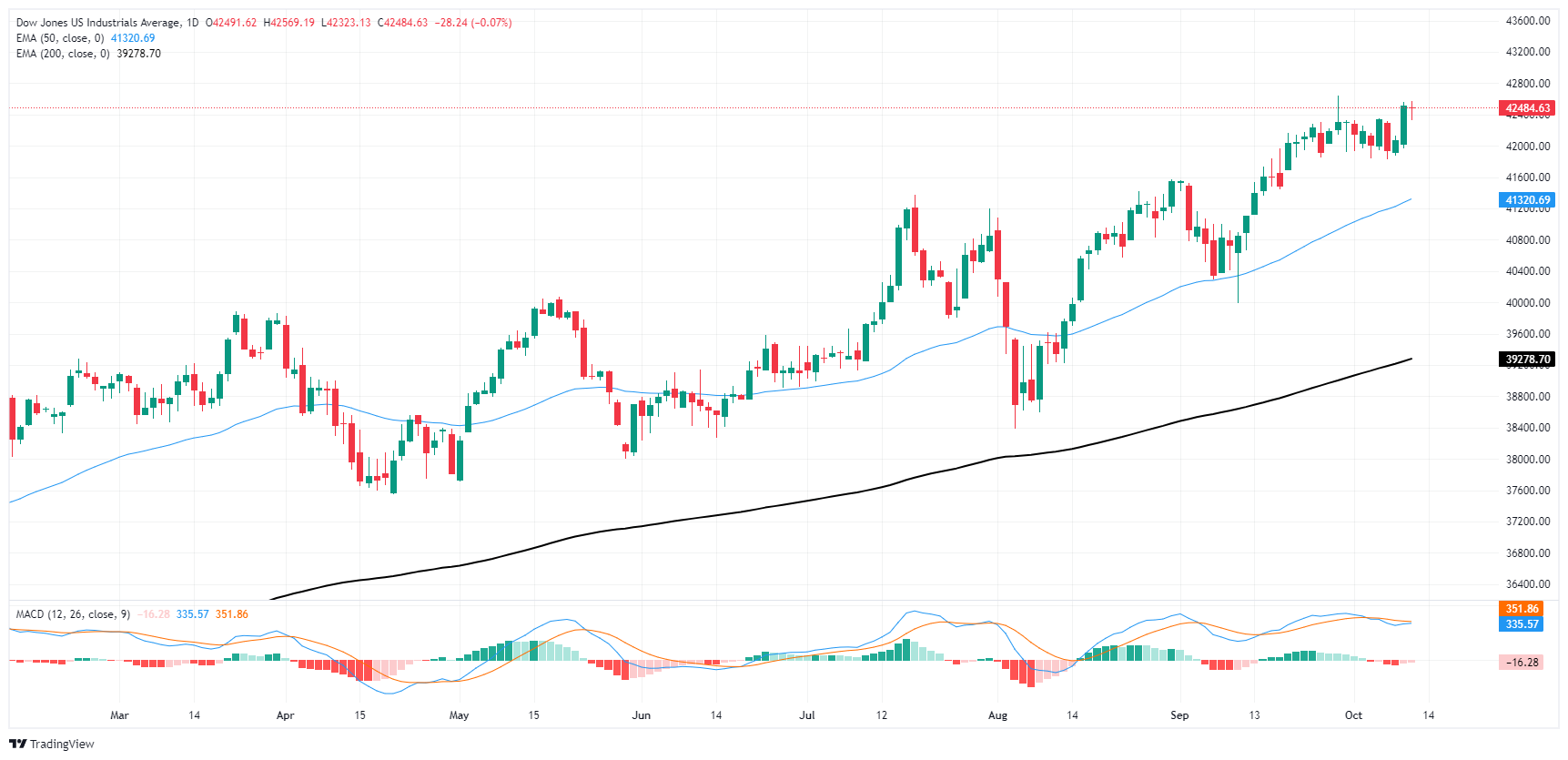Dow Jones Industrial Average recoils after hot CPI print
- The Dow Jones shed around 100 points on Thursday before grinding back to the middle.
- US CPI data came in hotter than expected, US Initial Jobless Claims also rose.
- Markets are firmly planted in bets for a 25 bps November cut.
The Dow Jones Industrial Average (DJIA) pared back on some of the week’s earlier gains after US Consumer Price Index (CPI) inflation figures from September failed to meet market expectations. US Initial Jobless Claims also accelerated to its highest week-on-week figure in over a year, flashing a warning sign that the labor market, while still relatively healthy, still has plenty of wiggle room for some slack in employment figures.
Headline US CPI inflation ticked down to 2.4% YoY in September, easing back from the previous 2.5%, but stuck stubbornly higher than the expected 2.3%. Annualized core CPI inflation also ticked higher to 3.3%, flummoxing the anticipated hold at 3.2%. Still-sticky inflation figures threaten market hopes for a faster, deeper pace of rate cuts from the Federal Reserve (Fed).
US Initial Jobless Claims rose to 258K for the week ended October 4, over and above the expected 230K and climbing above the previous week’s print of 225K. While still within the realm of reasonable, it was still the highest level of week-on-week new unemployment benefits seekers since May of 2023.
Investors are left in a tricky position after Thursday’s data points: Still-high inflation makes it even harder for the Fed to deliver further rate cuts, but softening labor figures could tilt the Fed into further, deeper rate trims. However, too-steep of a pivot into souring labor data would be a significant warning sign of an impending recession, which would certainly spike the pace of Fed rate cuts higher, but would outright threaten the stability of equity markets.
According to the CME’s FedWatch Tool, rate traders have piled back into bets of a 25 bps rate trim in November, with 90% odds the Fed will deliver a quarter-point rate cut on November 7. The remaining 10% pool is expecting no move at all from the Fed next month.
Dow Jones news
The Dow Jones struggled its way back to the even mark after an initial 100-point dump to kick off Thursday’s US market session. Despite recovering balance, a full two-thirds of the major equity board is testing into the red for the day. Amazon (AMZN) still managed to find the high side, climbing over 1% and testing north of $187 per share.
Dow Jones price forecast
The Dow Jones Industrial Average (DJIA) is showing signs of consolidation after rallying from early October lows. It's trading just below recent highs above 42600, with a slight 0.10% decline for the day. The 50-day exponential moving average (EMA) at 41,300 is providing strong support, and price action remains well above both the 50-day and the 200-day EMA at 39,173, confirming the broader uptrend.
Momentum indicators are showing mixed signals. The Moving Average Convergence Divergence (MACD) line is slightly above the signal line, suggesting a slowdown in upward momentum. Traders are closely monitoring whether the MACD line will cross below the signal line, which could be an early sign of a short-term pullback.
As long as the index continues to trade above key support levels, the upward trend remains intact. However, a break below the 50-day EMA could trigger more pronounced selling pressure, potentially pushing the index toward the 200-day EMA. Traders will be closely watching to see if the index can surpass current resistance levels or if it will enter a period of consolidation amid uncertainties in the macroeconomic environment.
Dow Jones daily chart
Inflation FAQs
Inflation measures the rise in the price of a representative basket of goods and services. Headline inflation is usually expressed as a percentage change on a month-on-month (MoM) and year-on-year (YoY) basis. Core inflation excludes more volatile elements such as food and fuel which can fluctuate because of geopolitical and seasonal factors. Core inflation is the figure economists focus on and is the level targeted by central banks, which are mandated to keep inflation at a manageable level, usually around 2%.
The Consumer Price Index (CPI) measures the change in prices of a basket of goods and services over a period of time. It is usually expressed as a percentage change on a month-on-month (MoM) and year-on-year (YoY) basis. Core CPI is the figure targeted by central banks as it excludes volatile food and fuel inputs. When Core CPI rises above 2% it usually results in higher interest rates and vice versa when it falls below 2%. Since higher interest rates are positive for a currency, higher inflation usually results in a stronger currency. The opposite is true when inflation falls.
Although it may seem counter-intuitive, high inflation in a country pushes up the value of its currency and vice versa for lower inflation. This is because the central bank will normally raise interest rates to combat the higher inflation, which attract more global capital inflows from investors looking for a lucrative place to park their money.
Formerly, Gold was the asset investors turned to in times of high inflation because it preserved its value, and whilst investors will often still buy Gold for its safe-haven properties in times of extreme market turmoil, this is not the case most of the time. This is because when inflation is high, central banks will put up interest rates to combat it. Higher interest rates are negative for Gold because they increase the opportunity-cost of holding Gold vis-a-vis an interest-bearing asset or placing the money in a cash deposit account. On the flipside, lower inflation tends to be positive for Gold as it brings interest rates down, making the bright metal a more viable investment alternative.